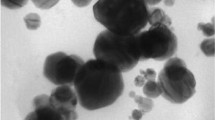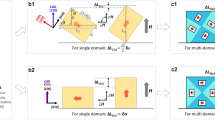Abstract
Rare earth giant magnetostrictive materials (GMMs) Tb1−xDyxFe2±δ (Tb–Dy–Fe) have been successfully employed in many microelectromechanical devices due to their excellent magnetostrictive properties at room temperature. However, Tb–Dy–Fe still shows a relatively large coercivity with high hysteresis, which inevitably limits its application range. Herein, micromagnetic simulations are performed to investigate the size effect of precipitated phase (α-Fe) on coercivity in Tb–Dy–Fe. Simulation results demonstrate that the coercivity is reduced from 31.46 to 12.48 mT with increasing the size of α-Fe from 4 to 50 nm in Tb–Dy–Fe since the precipitated phase of α-Fe can act as a magnetization reversal nucleus. This decreasing trend of coercivity can be well fitted with an inverse square relationship, which agrees well with the nucleation theory. Our study highlights that the coercivity of Tb–Dy–Fe can be tailored by tuning the size of α-Fe precipitation.
Graphical abstract

摘要
稀土超磁致伸缩材料 (GMMs) Tb1−xDyxFe2±δ (Tb–Dy–Fe)因其具有优异的室温磁致伸缩性能, 已成功应用于诸多微机电器件中。然而, Tb–Dy–Fe仍然表现出较大的矫顽力和高磁滞效应, 这不可避免地限制了它的应用范围。有鉴于此, 开展了微磁学模拟以研究析出相 (α-Fe) 尺寸对 Tb–Dy–Fe 矫顽力的影响。模拟结果表明, 随着 α-Fe 在 Tb–Dy–Fe 中的尺寸从 4 nm 增加到50 nm, 因 α-Fe析出相可以充当反磁化核, 矫顽力则相应地从 31.46 mT 降低到12.48 mT。矫顽力的下降趋势可以很好地拟合成平方反比关系, 并且也很好地符合形核场理论。本研究表明, 可以通过改变析出相 α-Fe的大小来有效调控Tb–Dy–Fe 的矫顽力。






Similar content being viewed by others
References
Hunter D, Osborn W, Wang K, Kazantseva N, Hattrick-Simpers J, Suchoski R, Takahashi R, Young ML, Mehta A, Bendersky LA, Lofland SE, Wuttig M, Takeuchi I. Giant magnetostriction in annealed Co1−xFex thin-films. Nat Commun. 2011;2(1):518. https://doi.org/10.1038/ncomms1529.
Zhou Y, Zhao X, Xu J, Fang Y, Chen G, Song Y, Li S, Chen J. Giant magnetoelastic effect in soft systems for bioelectronics. Nat Mater. 2021;20(12):1670. https://doi.org/10.1038/s41563-021-01093-1.
Clark AE. Magnetic and magnetoelastic properties of highly magnetostrictive rare earth-iron laves phase compounds. AIP Conf Proc. 1974;18(1):1015. https://doi.org/10.1063/1.2947192.
Clark AE. Chapter 7 magnetostrictive rare earth-Fe2 compounds. In: Handbook of ferromagnetic materials. Elsevier. 1980; 531. https://doi.org/10.1016/S1574-9304(05)80122-1.
Shirazi P, Lee T, Panduranga MK, N’Diaye AT, Barra A, Carman GP. Rare-earth orbital moment contributions to the magnetic anisotropy in magnetostrictive Tb0.3Dy0.7Fe2. Appl Phys Lett. 2021;118(16):162401. https://doi.org/10.1063/5.0049326.
Bergstrom R, Wuttig M, Cullen J, Zavalij P, Briber R, Dennis C, Garlea VO, Laver M. Morphotropic phase boundaries in ferromagnets: Tb1−xDyxFe2 alloys. Phys Rev Lett. 2013;111(1):017203. https://doi.org/10.1103/PhysRevLett.111.017203.
Ma T, Liu X, Pan X, Li X, Jiang Y, Yan M, Li H, Fang M, Ren X. Local rhombohedral symmetry in Tb0.3Dy0.7Fe2 near the morphotropic phase boundary. Appl Phys Lett. 2014;105(19):192407. https://doi.org/10.1063/1.4901646.
Olabi AG, Grunwald A. Design and application of magnetostrictive materials. Mater Des. 2008;29(2):469. https://doi.org/10.1016/j.matdes.2006.12.016.
Uchida H, Wada M, Koike K, Uchida HH, Koeninger V, Matsumura Y, Kaneko H, Kurino T. Giant magnetostrictive materials: thin film formation and application to magnetic surface acoustic wave devices. J Alloys Compd. 1994;211:576. https://doi.org/10.1016/0925-8388(94)90570-3.
Apicella V, Caponero MA, Davino D, Visone C. A magnetostrictive biased magnetic field sensor with geometrically controlled full-scale range. Sensor Actuat A Phys. 2018;280:475. https://doi.org/10.1016/j.sna.2018.08.014.
Yang S, Bao H, Zhou C, Wang Y, Ren X, Matsushita Y, Katsuya Y, Tanaka M, Kobayashi K, Song X, Gao J. Large magnetostriction from morphotropic phase boundary in ferromagnets. Phys Rev Lett. 2010;104(19):197201. https://doi.org/10.1103/PhysRevLett.104.197201.
Li Z, Li YQ, Liu WQ, Wu D, Chen H, Xia WX, Yue M. Origin of low coercivity of high La–Ce-containing Nd–Fe–B sintered magnets. Rare Met. 2021;40(1):180. https://doi.org/10.1007/s12598-020-01556-5.
Vivas LG, Yanes R, Berkov D, Erokhin S, Bersweiler M, Honecker D, Bender P, Michels A. Toward understanding complex spin textures in nanoparticles by magnetic neutron scattering. Phys Rev Lett. 2020;125(11):117201. https://doi.org/10.1103/PhysRevLett.125.117201.
Wang C, Zhu M-G. Overview of composition and technique process study on 2:17-type Sm–Co high-temperature permanent magnet. Rare Met. 2021;40(4):790. https://doi.org/10.1007/s12598-020-01514-1.
Sanz-Hernández D, Hierro-Rodriguez A, Donnelly C, Pablo-Navarro J, Sorrentino A, Pereiro E, Magén C, McVitie S, de Teresa JM, Ferrer S, Fischer P, Fernández-Pacheco A. Artificial double-helix for geometrical control of magnetic chirality. ACS Nano. 2020;14(7):8084. https://doi.org/10.1021/acsnano.0c00720.
Emdadi A, Hossein Nedjad S, Badri Ghavifekr H, Kavanlouei M, Alijan Farzad Lahiji F, Ramezankhani V. Microstructural dependence of magnetic and magnetostrictive properties in Fe–19 at% Ga. Rare Met. 2020;39(4):413. https://doi.org/10.1007/s12598-016-0800-x.
de la Venta J, Wang S, Saerbeck T, Ramírez JG, Valmianski I, Schuller IK. Coercivity enhancement in V2O3/Ni bilayers driven by nanoscale phase coexistence. Appl Phys Lett. 2014;104(6): 062410. https://doi.org/10.1063/1.4865587.
Guan W, Zhang Z, Wang D, Du Y. Coercivity in the Mg-doped CeCo3 permanent magnet: grain size and anisotropy variation effects. Phys Scripta. 2021;96(9):095807. https://doi.org/10.1088/1402-4896/ac04dd.
Gou J, Ma T, Liu X, Zhang C, Sun L, Sun G, Xia W, Ren X. Large and sensitive magnetostriction in ferromagnetic composites with nanodispersive precipitates. NPG Asia Mater. 2021;13(1):6. https://doi.org/10.1038/s41427-020-00276-7.
Hrkac G, Woodcock TG, Butler KT, Saharan L, Bryan MT, Schrefl T, Gutfleisch O. Impact of different Nd-rich crystal-phases on the coercivity of Nd–Fe–B grain ensembles. Scr Mater. 2014;70:35. https://doi.org/10.1016/j.scriptamat.2013.08.029.
Kim CS, Zha L, Li MN, Yang WY, Han JZ, Liu SQ, Du HL, Wang CS, Yang JB. Micromagnetic simulation for optimizing nanocomposite Nd2Fe14B/α-Fe permanent magnets by changing grain size and volume fraction. J Magn Magn Mater. 2021;523:167622. https://doi.org/10.1016/j.jmmm.2020.167622.
Westmoreland SC, Skelland C, Shoji T, Yano M, Kato A, Ito M, Hrkac G, Schrefl T, Evans RFL, Chantrell RW. Atomistic simulations of α-Fe/Nd2Fe14B magnetic core/shell nanocomposites with enhanced energy product for high temperature permanent magnet applications. J Appl Phys. 2020;127(13):133901. https://doi.org/10.1063/1.5126327.
Ried K, Schnell M, Schatz F, Hirscher M, Ludescher B, Sigle W, Kronmüller H. Crystallization behaviour and magnetic properties of magnetostrictive TbDyFe films. Phys Status Solidi A. 1998;167(1):195. https://doi.org/10.1002/(SICI)1521-396X(199805)167:1%3c195::AID-PSSA195%3e3.0.CO;2-C.
Goltsov VA, Vasiljev AG, Vlasenko NN, Fruchart D. Kinetics of hydrogen-induced diffusion phase transformation in binary and pseudobinary intermetallic compounds Tb1−XDyXFe2. Int J Hydrogen Energy. 2002;27(7):765. https://doi.org/10.1016/S0360-3199(01)00106-9.
Uchida H, Matsumura Y, Uchida H, Kaneko H. Progress in thin films of giant magnetostrictive alloys. J Magn Magn Mater. 2002;239(1):540. https://doi.org/10.1016/S0304-8853(01)00659-X.
Zhang ZM, Zhao XC, Zhou WP. Field dependence of magnetoresistance in half-metallic manganite. Eur Phys J Appl Phys. 2015;70(3):30601. https://doi.org/10.1051/epjap/2015150047.
Hu CC, Yang TN, Huang HB, Hu JM, Wang JJ, Shi YG, Shi DN, Chen LQ. Phase-field simulation of domain structures and magnetostrictive response in Tb1−xDyxFe2 alloys near morphotropic phase boundary. Appl Phys Lett. 2016;108(14):141908. https://doi.org/10.1063/1.4945684.
Zhang Z, Li J, Zhou W, Yang C, Cao Q, Wang D, Du Y. Mechanism of enhancement in magnetoresistance properties of manganite perovskite ceramics by current annealing. Ceram Int. 2018;44(4):3760. https://doi.org/10.1016/j.ceramint.2017.11.159.
Zhang ZM, Zhou WP, Li Q, Wang DH, Cao QQ, Du YW. Magnetoresistance in magnetite film: a theoretical and experimental investigation. J Magn Magn Mater. 2017;442:102. https://doi.org/10.1016/j.jmmm.2017.06.078.
Vansteenkiste A, Leliaert J, Dvornik M, Helsen M, Garcia-Sanchez F, Van Waeyenberge B. The design and verification of MuMax3. AIP Adv. 2014;4(10):107133. https://doi.org/10.1063/1.4899186.
Gilbert TL. A phenomenological theory of damping in ferromagnetic materials. IEEE Trans Magn. 2004;40(6):3443. https://doi.org/10.1109/TMAG.2004.836740.
Schrefl T, Fidler J. Micromagnetic simulation of magnetizability of nanocomposite Nd–Fe–B magnets. J Appl Phys. 1998;83(11):6262. https://doi.org/10.1063/1.367666.
Kronmüller H, Hilzinger HR. Incoherent nucleation of reversed domains in Co5Sm permanent magnets. J Magn Magn Mater. 1975;2(1):3. https://doi.org/10.1016/0304-8853(75)90097-9.
Zhao GP, Wang XL. Nucleation, pinning, and coercivity in magnetic nanosystems: an analytical micromagnetic approach. Phys Rev B. 2006;74(1):012409. https://doi.org/10.1103/PhysRevB.74.012409.
Acknowledgements
This work was financially supported by the National Key R&D Program of China (No. 2021YFB3501401), the National Natural Science Foundation of China (No. 52001103), Zhejiang Provincial Natural Science Foundation of China (No. LQ21E010001) and the Ten Thousand Talents Plan of Zhejiang Province of China (No. 2019R52014).
Author information
Authors and Affiliations
Corresponding authors
Ethics declarations
Conflict of interests
The authors declare that they have no conflict of interest.
Rights and permissions
Springer Nature or its licensor holds exclusive rights to this article under a publishing agreement with the author(s) or other rightsholder(s); author self-archiving of the accepted manuscript version of this article is solely governed by the terms of such publishing agreement and applicable law.
About this article
Cite this article
Zhang, FX., Hu, PQ., Zhang, ZM. et al. Tailoring coercive field in rare earth giant magnetostrictive materials by α-Fe precipitation. Rare Met. 42, 606–613 (2023). https://doi.org/10.1007/s12598-022-02145-4
Received:
Revised:
Accepted:
Published:
Issue Date:
DOI: https://doi.org/10.1007/s12598-022-02145-4




